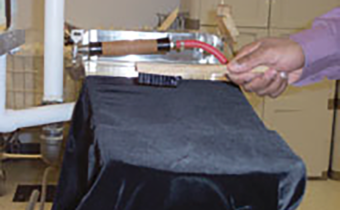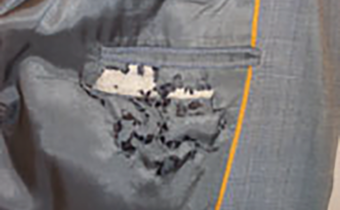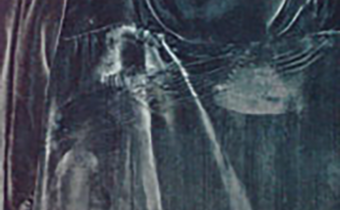While nice to look at, velvet fabrics can be difficult to clean properly. The biggest problem is that the fibers can become permanently matted if handled incorrectly.
TRUE VELVETS
● Identification
True velvet is usually made from rayon, silk, acetate, or a blend of these fibers. You must carefully examine velvets made of these fibers before processing since they can become permanently matted and flattened by moisture and pressure.
● Stain Removal
Stain removal should always be done on the front side (soft fuzzy side) of the fabric (see Fig. 1). Stain removal on the backside tends to pull out some of the velvet fibers. Since velvets usually come in deep rich colors, testing the dyes for colorfastness is very important.
Dry-side agents can be used without fear of flattening the fibers; however, acetone and some ink and glue removers will dissolve acetate and cause permanent damage (see Fig. 2). For this reason, it is not only necessary to check the fiber content of the velvet, but also necessary to check fiber content of the lining or trim.
Do not attempt any wetside stain removal on rayon or acetate velvets. Steam guns and stain removal agents containing water will permanently flatten the velvet fibers causing highlights or shiny areas (see Fig. 3).
● Dry Cleaning
Be sure to classify velvets into the correct color category before cleaning, especially since dyes on velvets often bleed during the cleaning cycle. Many dry cleaners will put velvets with their black or red loads. When doing this, keep in mind that other black and red garments in the load may have white pockets and waistbands. Cleaning a red velvet dress with a black pair of pants can leave you with pink pocket linings.
- Turn the garment inside out and place in a net bag.
- Use a cleaning cycle of five minutes in perc and 10 minutes in petroleum/hydrocarbon or GreenEarth.
NOTE: When dry cleaning velvets, it is advisable not to run the solvent through the filters because of possible dye bleeds. When the cleaning cycle is done, drain the solvent to the still. - Tumble dry at a low temperature of 120°F (49°C).
- Once the load has ended, remove the garment and hang it immediately to prevent the formation of wrinkles, which may be impossible to remove during finishing.
VELVETS OTHER THAN RAYON AND ACETATE
Fabrics resembling velvets can be made from cotton and cotton/polyester blends. These fabrics are referred to as velveteen. Velveteen garments can be processed with little to no difficulty. When you are uncertain of the fiber content, however, treat the item as if it were true velvet.
● Stain Removal
As with any stain removal procedure, test for colorfastness before starting. Wet-side stain removal is safe on these fabrics provided that they are colorfast.
Dry-side stain removal is also acceptable for velveteen fabrics after checking for colorfastness.
● Dry Cleaning
Use the procedure described for true velvets for velveteen.
● Wet Cleaning
Unlike true velvets, cotton and polyester velveteen can often be wet cleaned. Test for colorfastness since the dyes on these fabrics tend to bleed.
- Turn the garment inside out and place it in a net bag.
- Clean on a short cycle delicate cycle, or hand wash in cool water using a detergent designed for wet cleaning.
- Rinse in cool water with a wet cleaning conditioner; then extract.
- Tumble dry on low for three minutes; then hang to dry the remaining moisture.
This article is from DLI’s TOI-716




